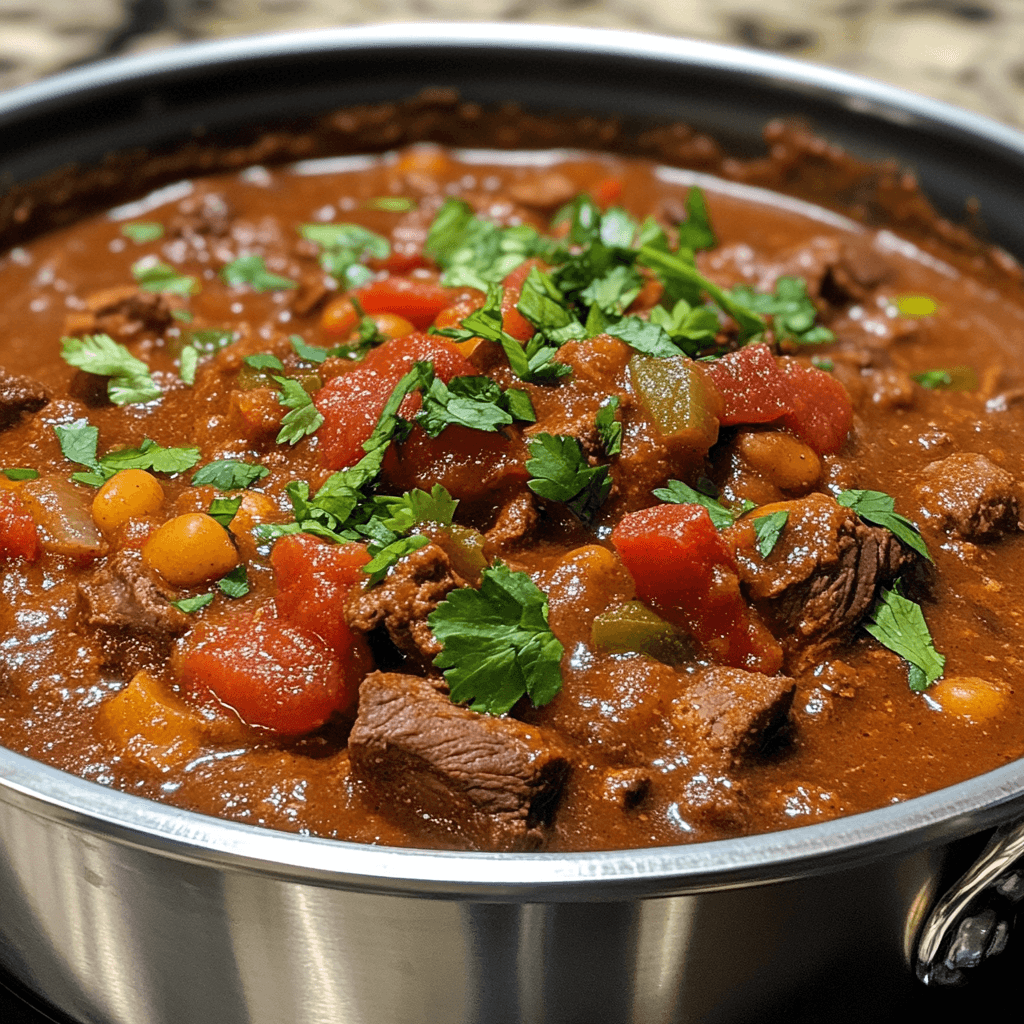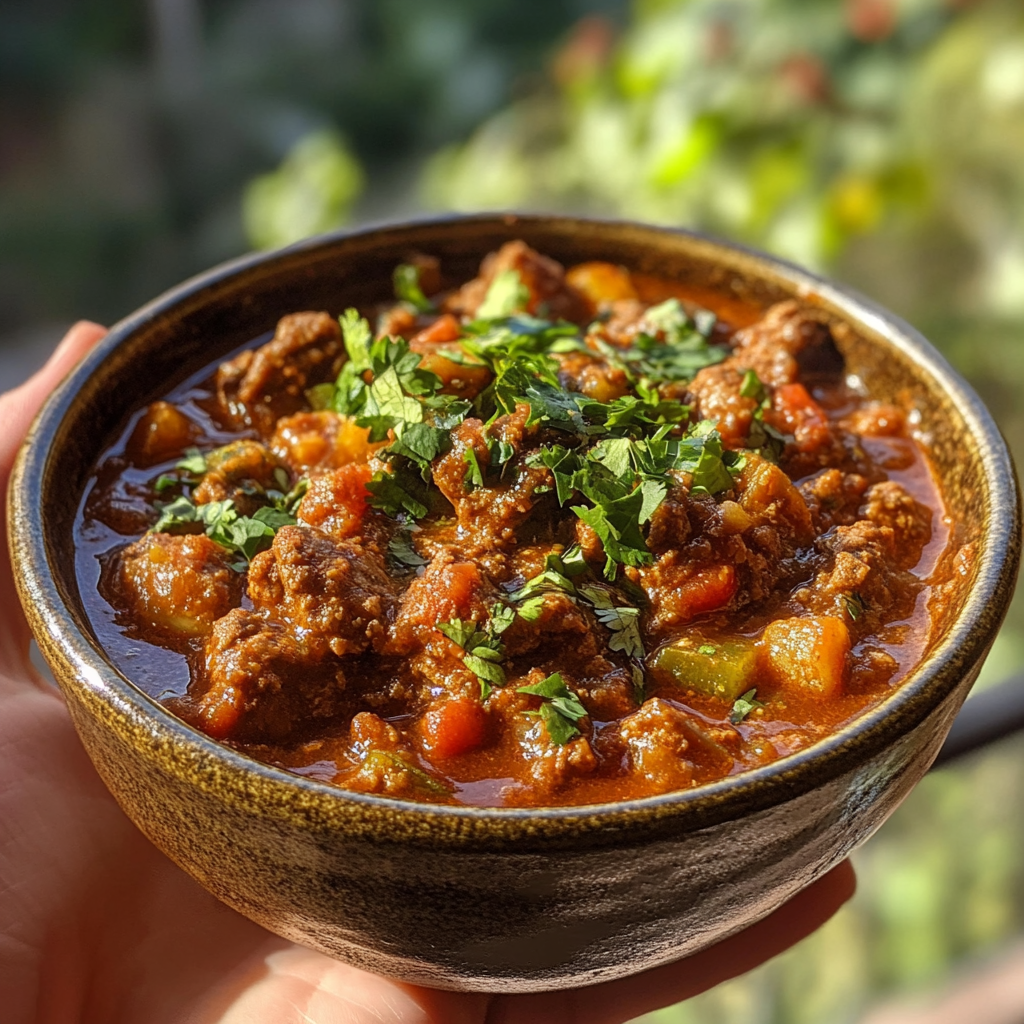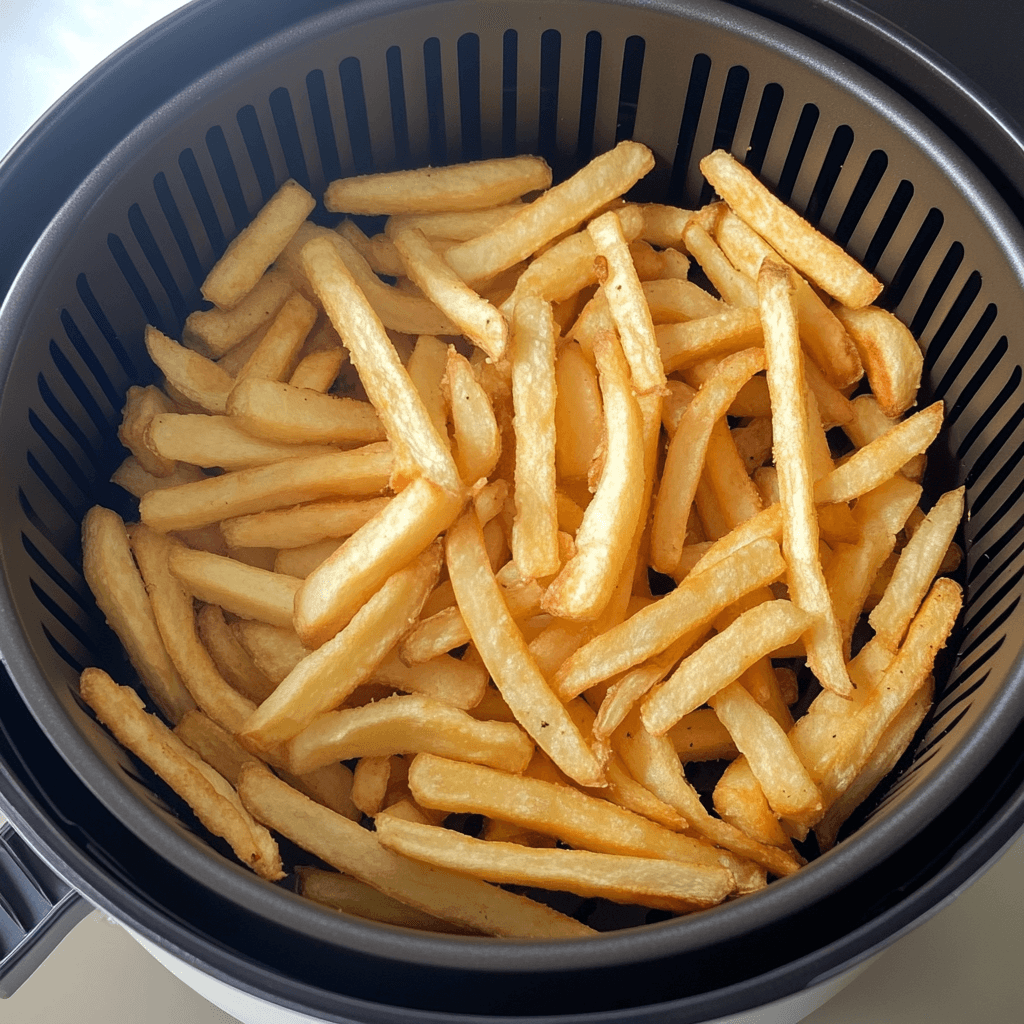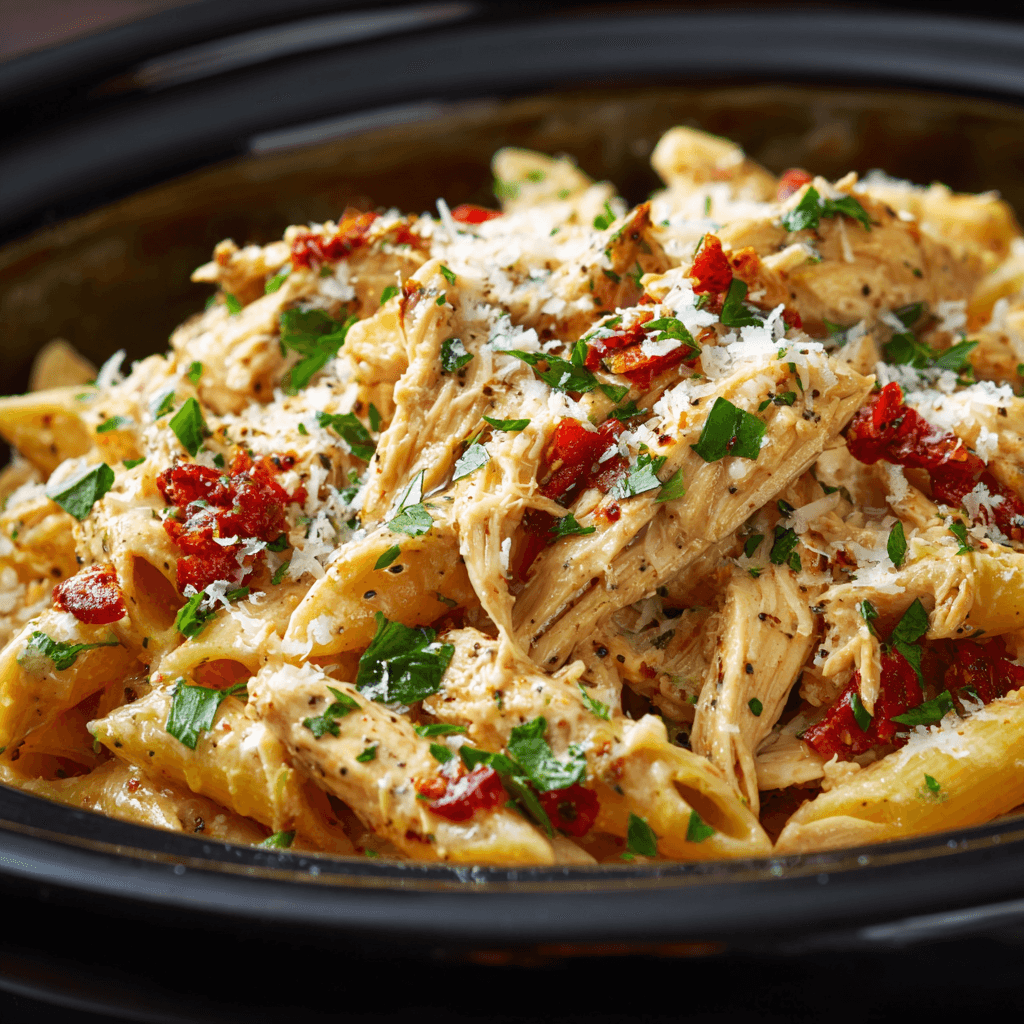Introduction to Steak Chili
What is Steak Chili?
Steak chili recipe is the ultimate way to elevate your chili game with tender chunks of steak and bold, rich spices. Unlike traditional ground beef chili, this dish uses premium cuts of meat, creating a hearty, flavorful meal that’s perfect for cozy dinners or lively game-day gatherings. With its irresistible combination of textures and customizable flavors, this steak chili recipe is a guaranteed crowd-pleaser.
Why Steak Chili Stands Out Among Chili Recipes
Steak chili distinguishes itself by its texture, depth of flavor, and versatility. The use of steak provides a robust, meaty bite that absorbs the spices and enhances the dish’s overall flavor. Whether you’re preparing a casual dinner or hosting a game-day party, steak chili is a crowd-pleaser that stands out for its premium ingredients and hearty appeal. Its adaptability also allows for endless customization, from the choice of steak cuts to the addition of unique spices.
The History of Chili Recipes
Origins of Chili Dishes
Chili’s roots can be traced back to the indigenous people of the Americas, who combined chili peppers with meat to create flavorful stews. As Spanish colonists and settlers moved across the Americas, they incorporated local ingredients, resulting in the evolution of regional chili recipes. By the 19th century, chili had become a staple dish in the southwestern United States, particularly in Texas.
Evolution of Chili with Steak
While traditional chili recipes often relied on ground or shredded meat, steak chili emerged as a modern twist. This variation gained popularity with the rise of gourmet cooking, as chefs and home cooks sought to refine classic dishes with high-quality ingredients. By using steak, this version emphasizes quality and texture, offering a luxurious take on a beloved classic.
Choosing the Right Ingredients
Selecting the Perfect Steak
The key to exceptional steak chili lies in choosing the right cut of meat. Opt for cuts that balance tenderness with flavor, such as sirloin, chuck, or brisket. These cuts are ideal for slow cooking, allowing the meat to become tender while absorbing the chili’s bold flavors. Trim excess fat, but leave enough to add richness to the dish.
Essential Spices and Seasonings
A great steak chili requires a harmonious blend of spices and seasonings. The core ingredients include chili powder, cumin, garlic, and paprika, which create the dish’s signature heat and smoky flavor. For added depth, consider using smoked paprika, cinnamon, or cocoa powder. Don’t forget to season generously with salt and pepper, and adjust the spice level to suit your taste.
By combining the right steak with a medley of spices, you can craft a steak chili that’s both comforting and unforgettable.
Preparing the Steak
Best Cuts for Chili
When making steak chili, the choice of cut is critical for flavor and tenderness. Here are some of the best cuts for chili:
- Chuck Roast: Known for its marbling, chuck roast becomes tender and flavorful when slow-cooked, making it a top choice for chili.
- Sirloin: This lean cut is ideal if you prefer a lighter texture while still enjoying rich, beefy flavor.
- Brisket: Perfect for those who love a smoky, melt-in-your-mouth bite, brisket works exceptionally well in chili when cooked low and slow.
- Stew Meat: Pre-cut beef labeled as “stew meat” is a convenient option, often derived from tougher cuts that soften beautifully with extended cooking.
How to Dice Steak for Optimal Texture
Properly preparing the steak is crucial to achieving the perfect texture in your chili:
- Chill the Meat: Refrigerate the steak for about 20 minutes before cutting to firm it up, making it easier to dice.
- Trim Excess Fat: Remove large chunks of fat, but leave some for added flavor.
- Cut Uniform Pieces: Dice the steak into 1-inch cubes for even cooking and a satisfying bite.
- Against the Grain: Cut the steak against the grain to break down the muscle fibers, ensuring tenderness.
Key Vegetables for Chili
Selecting the Right Peppers
Peppers are a cornerstone of chili, providing flavor, color, and heat. Consider these options:
- Bell Peppers: Mild and slightly sweet, bell peppers add color and a subtle crunch to chili.
- Jalapeños: A medium-spicy choice for those who enjoy a little heat without overwhelming the dish.
- Poblano Peppers: These mildly spicy peppers have a smoky flavor that pairs beautifully with steak.
- Chili Peppers: For those who love heat, serrano or habanero peppers will elevate the spice level.
Using Onions, Tomatoes, and Beans
- Onions: Yellow or white onions are ideal for their sweet yet pungent flavor, which mellows during cooking. Dice finely to ensure they blend into the chili base.
- Tomatoes: Use a combination of canned diced tomatoes and tomato paste for a rich, thick chili base. Fire-roasted tomatoes can add a smoky dimension.
- Beans: Kidney, black, or pinto beans are traditional choices, offering heartiness and protein. If you prefer a bean-free chili, feel free to omit them.
Equipment You Need
Essential Cookware for Chili
- Dutch Oven or Heavy Pot: A heavy-bottomed Dutch oven distributes heat evenly, making it perfect for slow-cooking chili.
- Slow Cooker: Ideal for set-it-and-forget-it convenience, a slow cooker allows the flavors to meld over time.
- Large Skillet: Use a large skillet to brown the steak before adding it to the chili, sealing in flavor.
Tools for Steak Preparation
- Sharp Chef’s Knife: A high-quality knife ensures clean, precise cuts of steak.
- Cutting Board: Opt for a sturdy cutting board to handle the dicing of meat and vegetables.
- Meat Thermometer: Although not essential, a meat thermometer can help ensure the steak reaches the perfect level of doneness before being incorporated into the chili.
- Wooden Spoon or Ladle: These tools are perfect for stirring the chili and ensuring even cooking.
With the right preparation, ingredients, and equipment, your steak chili will be a rich, flavorful masterpiece!
The Step-by-Step Cooking Process
Browning the Steak
- Preheat the Pan: Heat a large skillet or Dutch oven over medium-high heat. Add a small amount of oil, such as olive or vegetable oil, to prevent sticking.
- Season the Steak: Generously season the diced steak with salt and pepper, and optionally, a pinch of chili powder for extra flavor.
- Sear in Batches: Avoid overcrowding the pan. Cook the steak in small batches, searing each side until browned (about 2-3 minutes per side). This step locks in juices and enhances the meat’s flavor.
Building Layers of Flavor
- Sauté Aromatics: In the same pan, sauté diced onions, garlic, and your chosen peppers until softened and fragrant.
- Add Spices: Stir in chili powder, cumin, smoked paprika, and any other desired spices. Cook for 1-2 minutes to toast the spices, intensifying their flavor.
- Deglaze the Pan: Pour in a splash of broth, wine, or beer to loosen the flavorful browned bits stuck to the bottom of the pan.
- Combine Ingredients: Add the browned steak, canned tomatoes, tomato paste, and beans (if using). Stir to mix well.
Simmering to Perfection
- Add Liquid: Pour in beef broth or water until the ingredients are just covered. Bring the mixture to a gentle boil.
- Reduce Heat: Lower the heat to a simmer and cover the pot. Let it cook slowly for at least 1-2 hours, stirring occasionally.
- Check for Doneness: Ensure the steak is tender and the flavors have melded beautifully. Adjust seasoning with salt and pepper as needed.
Tips for Perfect Chili Texture
Controlling the Thickness
- For a Thicker Chili:
- Use less liquid initially, and let the chili simmer uncovered to reduce excess moisture.
- Stir in a tablespoon of masa harina (corn flour) or cornstarch mixed with water to thicken the chili near the end of cooking.
- For a Thinner Chili:
- Add extra broth, water, or even tomato juice to achieve your preferred consistency.
Balancing Liquid and Ingredients
- Balance is Key: Ensure the liquid complements the solid ingredients. Too much liquid can dilute the flavor, while too little can lead to a dry chili.
- Stir Regularly: Prevent sticking and ensure even cooking by stirring the chili periodically during the simmering process.

Popular Variations of Steak Chili
Spicy Steak Chili
- Add More Heat: Incorporate serrano or habanero peppers for extra spice.
- Use Hot Spices: Add cayenne pepper, chipotle powder, or hot sauce to increase the heat level.
- Optional Garnish: Serve with jalapeño slices or a dollop of spicy salsa for added kick.
Bean-Free Steak Chili
- Skip the Beans: Focus on the steak and vegetables for a hearty, low-carb chili.
- Extra Vegetables: Add zucchini, mushrooms, or carrots for a filling alternative.
- Thicken Naturally: Use reduced liquid and simmer longer to achieve the desired consistency.
Sweet and Smoky Steak Chili
- Add Sweetness: Stir in a touch of brown sugar, honey, or molasses to balance the smokiness.
- Enhance the Smoky Flavor: Use smoked paprika, chipotle peppers in adobo, or a splash of liquid smoke.
- Optional Garnish: Top with a sprinkle of cheddar cheese and a dollop of sour cream for a creamy finish.
With these steps, tips, and variations, you can create steak chili that’s customized to your taste and sure to impress!
Serving Suggestions
Pairing with Side Dishes
- Cornbread: A classic partner for chili, cornbread’s sweet and buttery flavor balances the spice and heartiness of the steak chili.
- Rice: Serve your chili over a bed of steamed white or brown rice for a filling and satisfying meal.
- Tortilla Chips: Use crispy tortilla chips for dipping or as a crunchy base for chili nachos.
- Roasted Vegetables: A side of roasted vegetables, such as Brussels sprouts or sweet potatoes, adds a nutritious and flavorful contrast.
- Salad: Pair with a simple green salad dressed with a tangy vinaigrette to cut through the richness of the chili.
Best Toppings for Steak Chili
- Shredded Cheese: Cheddar, Monterey Jack, or even a smoky Gouda can melt beautifully over hot chili.
- Sour Cream: A dollop of sour cream adds creaminess and helps tame the spice.
- Avocado: Sliced or diced avocado provides a fresh, creamy element.
- Chopped Fresh Herbs: Sprinkle chopped cilantro, parsley, or green onions for a burst of freshness.
- Pickled Jalapeños: Add tangy heat with pickled jalapeño slices.
- Crushed Tortilla Chips: Sprinkle crushed chips on top for a crunchy texture.
How to Store and Reheat Steak Chili
Tips for Freezing
- Cool Completely: Allow the chili to cool to room temperature before freezing to prevent ice crystals from forming.
- Portion Wisely: Divide the chili into individual portions or meal-sized containers for easy thawing and reheating.
- Use Airtight Containers: Store the chili in freezer-safe containers or heavy-duty freezer bags, removing as much air as possible.
- Label and Date: Clearly label each container with the date to ensure you use it within 3 months for optimal flavor.
Best Practices for Reheating
- Thaw Safely: Transfer frozen chili to the refrigerator to thaw overnight. For quicker results, use the defrost setting on your microwave.
- Reheat on the Stove: Warm the chili in a saucepan over medium heat, stirring occasionally to ensure even heating. Add a splash of broth or water if it’s too thick.
- Microwave Option: Place chili in a microwave-safe dish, cover loosely, and heat in short intervals, stirring between each to avoid uneven heating.
Nutritional Benefits of Steak Chili
Protein-Packed Meals
- High in Protein: Steak chili provides a robust source of protein from the beef and beans (if included), promoting muscle repair and growth.
- Rich in Iron: The beef and kidney beans contribute to a high iron content, essential for red blood cell production and energy.
- Full of Fiber: Adding beans or vegetables boosts the fiber content, supporting digestive health.
Low-Carb Options for Steak Chili
- Bean-Free Variation: Skip the beans to make a low-carb chili, ideal for keto or paleo diets.
- Focus on Vegetables: Substitute beans with low-carb vegetables like zucchini or cauliflower for a lighter alternative.
- Healthy Fats: Add avocado or sour cream for healthy fats that complement a low-carb lifestyle.
Steak chili is not just a flavorful dish—it’s a versatile, nutritious meal that can fit a variety of dietary needs and preferences!
Frequently Asked Questions
What kind of steak is best for chili?
The best steak for chili depends on your preferences for flavor and texture, but common choices include:
- Chuck Roast: Known for its rich marbling, chuck roast becomes tender and flavorful when slow-cooked.
- Brisket: Ideal for a smoky, melt-in-your-mouth chili.
- Sirloin: A leaner option that still delivers a hearty, beefy flavor.
- Stew Meat: Pre-cut beef chunks, often derived from tougher cuts, are convenient and well-suited for slow cooking.
What is cowboy chili made of?
Cowboy chili is a hearty, rustic variation of chili that often features:
- Chunky Meat: Typically uses steak, ground beef, or a mix of the two.
- Beans or No Beans: Some versions include beans, while others stay true to Texas-style with no beans.
- Bold Spices: Chili powder, cumin, and smoked paprika for a robust flavor.
- Hearty Vegetables: Peppers, onions, and sometimes tomatoes.
Cowboy chili is often cooked over an open fire or in a cast-iron pot, emphasizing its rustic, frontier origins.
What secret ingredient will deepen the flavor of your chili?
Adding a unique ingredient can enhance and deepen the flavor of chili. Some popular options include:
- Dark Chocolate or Cocoa Powder: Adds a subtle richness and complements the spices.
- Coffee or Espresso: A small amount of brewed coffee provides a bold, earthy undertone.
- Beer: A splash of dark beer, like stout or porter, can add complexity.
- Molasses or Brown Sugar: Balances the heat and adds a hint of sweetness.
Experimenting with these ingredients can take your chili to the next level.
How is Texas chili different?
Texas chili, also known as “chili con carne,” stands out for its simplicity and focus on meat:
- No Beans: Authentic Texas chili avoids beans, focusing solely on beef.
- No Tomatoes: Often excludes tomatoes or uses them sparingly.
- Rich Spices: Relies heavily on chili peppers and a robust spice blend for flavor.
- Thicker Consistency: Typically thicker and less soupy than other chili variations.
Texas chili is all about celebrating the bold flavors of beef and chili peppers, with minimal additional ingredients.
These answers aim to clarify common questions and help you perfect your steak chili!
Here’s a paragraph incorporating internal linking opportunities for a steak chili recipe article:
For a truly smoky and savory twist to your steak chili recipe, you might draw inspiration from The Ultimate Brisket Chili Recipe, which emphasizes bold flavors and the richness of slow-cooked beef. If you’re looking for additional methods to perfect your chili’s base, consider the approach in The Perfect Chili Recipe with Enchilada Sauce and Ground Beef, which highlights the role of enchilada sauce for a tangy depth. Finally, those curious about alternative variations might enjoy exploring The Ultimate Cowboy Chili Recipe, a hearty, no-frills option perfect for any occasion.
This strategy seamlessly integrates relevant internal links to guide readers to other engaging content on the site.
What’s the best way to store leftovers?
Keep leftovers in an airtight container in the fridge for up to 4 days. Reheat in the microwave or oven until hot and bubbly. For food safety tips, refer to USDA guidelines on leftovers .
Troubleshooting Common Problems
Avoiding Tough Meat
Tough meat can ruin the texture of steak chili. To ensure your steak is tender:
- Choose the Right Cut: Opt for well-marbled cuts like chuck roast or brisket, which become tender during slow cooking.
- Cook Low and Slow: Simmer the chili over low heat for at least 1-2 hours to break down the meat’s connective tissue.
- Pre-Sear the Steak: Browning the meat before adding it to the chili helps lock in moisture and improve texture.
- Avoid Overcooking: Keep an eye on cooking time—overcooking can cause the meat to dry out.
Fixing Overly Spicy Chili
If your chili turns out too spicy, don’t worry! Here are a few ways to balance the heat:
- Add Dairy: Stir in a dollop of sour cream, plain yogurt, or even shredded cheese to neutralize spiciness.
- Incorporate Sweetness: A teaspoon of sugar, honey, or a splash of orange juice can help balance the heat.
- Dilute with Liquid: Add more broth, tomato sauce, or beans to spread out the spice.
- Serve with Starchy Sides: Pair your chili with rice, cornbread, or crackers to offset the heat.
The Best Drinks to Pair with Steak Chili
Beer
Beer is a classic choice for pairing with steak chili, enhancing its hearty flavors:
- Dark Beers: Stouts and porters complement the smoky, rich notes of chili.
- Amber Ales: These have a balanced flavor that pairs well with spicy and savory dishes.
- Lagers: Crisp and refreshing, lagers offer a light contrast to the boldness of chili.
Wine
Wine can be an elegant pairing with steak chili:
- Red Wines: Choose a bold red, such as a Zinfandel, Syrah, or Malbec, to match the chili’s depth and spice.
- Chilled Rosé: A dry rosé provides a refreshing, fruity balance to spicy chili.
- Light Reds: A Pinot Noir offers a smooth, less intense option for those who prefer a lighter red.
Non-Alcoholic Options
For non-drinkers or family-friendly meals, try these options:
- Iced Tea: A lightly sweetened or unsweetened iced tea pairs beautifully with chili.
- Sparkling Water with Citrus: Add a slice of lime or orange for a crisp, palate-cleansing drink.
- Root Beer: The rich, creamy flavor of root beer complements the hearty nature of steak chili.
- Milk: A surprising but effective option for cutting through spice and soothing the palate.
With these tips and pairing suggestions, you can elevate your steak chili experience and handle any challenges with confidence!
Conclusion
Why Steak Chili is the Perfect Comfort Food
Steak chili embodies everything we love about comfort food—it’s hearty, flavorful, and endlessly customizable. The tender chunks of steak, infused with bold spices and rich ingredients, create a dish that satisfies both the stomach and the soul. Whether you’re enjoying a bowl on a chilly evening or serving it up for a crowd during game day, steak chili brings warmth and joy to the table. Its versatility allows you to tailor the recipe to your taste, making it as spicy, smoky, or sweet as you like. With its combination of simplicity and gourmet flair, steak chili truly stands out as the ultimate comfort food, perfect for any occasion.





